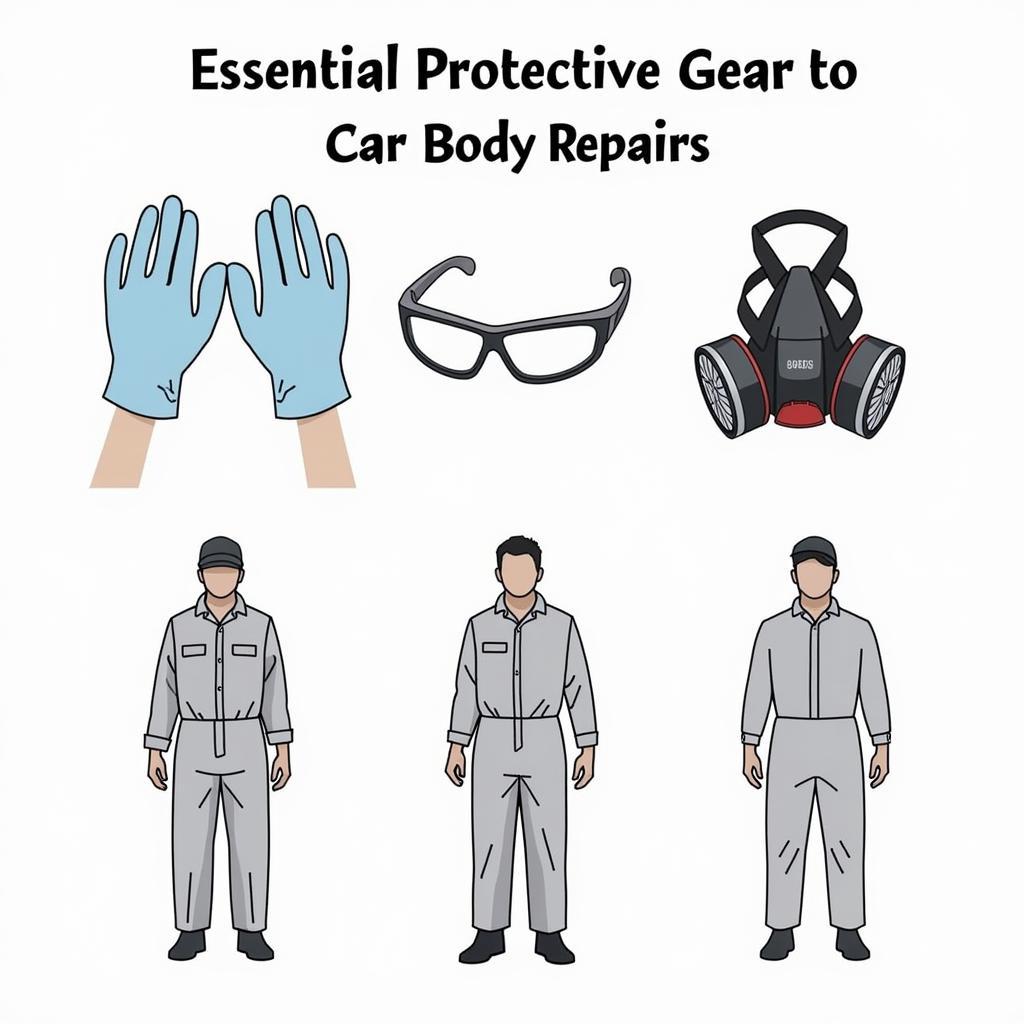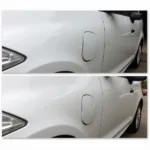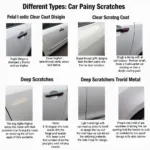Car body repair inhaling dust is a serious health hazard that often goes overlooked. From sanding filler to grinding welds, many car body repair tasks create fine dust particles that can easily be inhaled, posing significant risks to your respiratory system. This article will delve into the dangers, preventive measures, and best practices to safeguard your health during car body repair.
Repairing a car body often involves processes that generate a substantial amount of dust, including sanding, grinding, and painting. This dust can contain various harmful substances, depending on the materials being worked on. For instance, sanding body filler can release fine particles of resin and fiberglass, while grinding metal generates metallic dust. Failing to take appropriate precautions can lead to the inhalation of these hazardous particles, which can have serious health implications. You can find helpful information on car body repair in our car body repair manual.
Understanding the Risks of Car Body Repair Dust Inhalation
The risks associated with car body repair inhaling dust are diverse and depend on the specific type of dust inhaled. Some common risks include:
-
Respiratory Irritation: This can manifest as coughing, sneezing, shortness of breath, and a burning sensation in the throat and lungs. Inhaling dust can also aggravate pre-existing respiratory conditions like asthma and bronchitis.
-
Metal Fume Fever: Welding and grinding galvanized steel can release zinc oxide fumes, leading to metal fume fever, a flu-like illness with symptoms such as fever, chills, muscle aches, and nausea.
-
Long-Term Lung Damage: Prolonged exposure to certain types of dust, like asbestos (found in older vehicles) and silica (found in some fillers and paints), can cause serious lung diseases such as silicosis, asbestosis, and even lung cancer.
-
Eye Irritation: Dust particles can irritate the eyes, causing redness, itching, and watering. In severe cases, corneal abrasions can occur.
-
Skin Irritation: Contact with certain dusts can cause skin irritation, rashes, and allergic reactions.
Protective Measures for Car Body Repair Dust
Taking appropriate precautions is crucial to minimizing the risks of inhaling dust during car body repair. Here’s a breakdown of essential protective measures:
-
Wear a Respirator: A high-quality respirator, specifically designed for particulate matter, is the most effective way to prevent dust inhalation. Make sure it fits properly and is rated for the type of dust you are working with.
-
Ventilate Your Workspace: Ensure adequate ventilation in your work area to minimize the concentration of dust particles in the air. Use exhaust fans, open doors and windows, or work outdoors whenever possible. Consider a dedicated car body repairs ash station for dust collection.
-
Use Dust Extraction Systems: Connect sanding and grinding tools to dust extraction systems to capture dust at the source. This is a highly effective method for reducing airborne dust particles.
-
Wear Protective Clothing: Cover exposed skin with long sleeves, pants, and gloves to prevent skin irritation and minimize dust contamination.
-
Practice Good Hygiene: Wash your hands thoroughly after working with dusty materials and avoid touching your face or eyes.
 Essential Protective Gear for Car Body Repair: Respirator, Gloves, Goggles
Essential Protective Gear for Car Body Repair: Respirator, Gloves, Goggles
Best Practices for Safe Car Body Repair
Beyond the essential protective measures, incorporating these best practices can further enhance your safety:
-
Wet Sanding: Whenever possible, use wet sanding techniques to minimize dust generation.
-
Regularly Clean Your Workspace: Clean up dust and debris regularly to prevent it from accumulating and becoming airborne. Check out our guide on car body rust repair diy for cleaning tips.
-
Choose Low-Dust Materials: Opt for low-dust body fillers, sanding discs, and other materials to reduce the amount of dust produced.
-
Stay Informed: Keep up-to-date on the latest safety recommendations and best practices for car body repair.
-
Inspect Your Equipment: Regularly inspect your respirator, dust extraction systems, and other safety equipment to ensure they are functioning correctly.
“Investing in high-quality respiratory protection is paramount for anyone involved in car body repair. Don’t compromise on your health,” advises John Davies, Certified Automotive Technician and Safety Consultant.
Minimizing Dust Exposure: A Proactive Approach
By taking a proactive approach to minimizing dust exposure, you can significantly reduce the risks associated with car body repair. Remember, prevention is always better than cure. You can find a comprehensive list of recommended tools for car body repair in our car body repair tools uk guide.
Conclusion
Car body repair inhaling dust can have serious health consequences. By understanding the risks, taking appropriate protective measures, and following best practices, you can protect your respiratory health and ensure a safe working environment. Prioritizing safety is not just good practice; it’s an investment in your long-term well-being.
FAQ
- What type of respirator is best for car body repair?
- How often should I replace my respirator filters?
- What are the symptoms of metal fume fever?
- What are the long-term effects of silica dust inhalation?
- How can I improve ventilation in my workspace?
- Are there any low-dust alternatives to traditional body fillers?
- What are the best practices for cleaning up dust after car body repair?
Need assistance? Contact us via WhatsApp: +1(641)206-8880 or Email: cardiagtechworkshop@gmail.com. Our customer support team is available 24/7.


